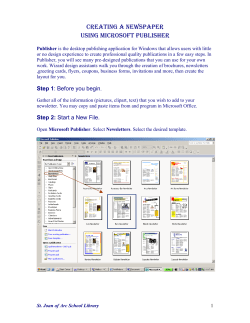
How to become a PEPPOL Access Point Provider
How to become a PEPPOL Access Point Provider How to become a PEPPOL Access Point Provider Page: 2 (26) Version: 2 Date: 19.04.2012 Statement of copyright This deliverable is released under the terms of the Creative Commons Licence accessed through the following link: http://creativecommons.org/licenses/by/3.0/. In short, it is free to Share — to copy, distribute and transmit the work Remix — to adapt the work Under the following conditions Attribution — You must attribute the work in the manner specified by the author or licensor (but not in any way that suggests that they endorse you or your use of the work). Page 2 of 26 How to become a PEPPOL Access Point Provider Page: 3 (26) Version: 2 Date: 19.04.2012 Table of Contents Table of Contents ............................................................................................. 3 1 2 Introduction ................................................................................................ 5 Background Information ............................................................................. 5 2.1 2.2 2.3 2.4 2.5 3 A bit more about the Transport Infrastructure ................................................ 6 Publishing the Capabilities of PEPPOL Participants ..................................... 6 The PEPPOL Central Registry ...................................................................... 6 Security and Trust .......................................................................................... 7 The PEPPOL Enterprise Interoperability Architecture ................................... 7 Providing an Access Point ......................................................................... 8 3.1 Organizational Considerations ....................................................................... 8 3.1.1 PEPPOL Coordinating Authority ............................................................. 8 4 PEPPOL Regional Authorities .................................................................. 10 4.1 Commercial Considerations ......................................................................... 10 4.2 Legal/Contractual Considerations ................................................................ 11 4.3 Operational Considerations ......................................................................... 12 4.4 Business Process Considerations ............................................................... 13 4.5 Technology Considerations ......................................................................... 14 4.5.1 PEPPOL Transport Infrastructure ......................................................... 14 5 How to establish an Access Point ............................................................ 16 5.1 Commercial Activities .................................................................................. 16 5.1.1 Identify customer requirements ............................................................ 16 5.1.2 Create business model ......................................................................... 17 5.1.3 Recruit participants ............................................................................... 17 5.2 Organizational Activities .............................................................................. 17 5.2.1 Identify governance community ............................................................ 17 5.2.2 Register with PEPPOL Authority .......................................................... 17 5.3 Legal/Contractual Activities ......................................................................... 18 5.3.1 Establish participant service agreements ............................................. 18 5.3.2 Establish PEPPOL Transport Infrastructure Agreements ..................... 18 5.4 Operational Activities ................................................................................... 19 5.4.1 Identify operational and technical capacity ........................................... 19 5.4.2 Provide PEPPOL Business Process Services ...................................... 19 5.4.3 Provide Service Metadata Publisher .................................................... 19 5.4.4 Provide Access Point ............................................................................ 19 5.4.5 Provide support for services ................................................................. 20 5.5 Business Process Activities ......................................................................... 20 5.5.1 Develop Business Process Services .................................................... 20 5.6 Technology Activities ................................................................................... 20 5.6.1 Develop Access Point ........................................................................... 20 5.6.2 Develop Service Metadata Publisher ................................................... 21 5.6.3 Develop customer connectivity ............................................................. 21 6 Frequently Asked Questions .................................................................... 22 6.1 6.2 6.3 6.4 6.5 Is there any PEPPOL funding to provide an Access Point? ........................ 22 What support do I get as an Access Point provider? ................................... 22 Is there a list of all Access Points? .............................................................. 22 Why do I need a digital certificate? .............................................................. 22 Who defines the BusDox standards? .......................................................... 23 Page 3 of 26 How to become a PEPPOL Access Point Provider Page: 4 (26) Version: 2 Date: 19.04.2012 6.6 6.7 6.8 6.9 6.10 6.11 7 Where do I find more technical information? ............................................... 23 How is my Access Point certified? ............................................................... 23 What do my customers need to know about PEPPOL services? ................ 23 Is using PEPPOL mandatory for government agencies? ............................ 23 Will my customers need new software to use PEPPOL? ............................ 23 What business processes does PEPPOL support? ..................................... 24 Reference Information .............................................................................. 25 7.1 7.2 Definitions .................................................................................................... 25 Glossary of Terms ....................................................................................... 26 Page 4 of 26 How to become a PEPPOL Access Point Provider Page: 5 (26) Version: 2 Date: 19.04.2012 1 Introduction This publication sets out to guide you through the decision process and subsequent actions for becoming a PEPPOL Access Point provider. It starts by explaining some basic concepts and terms then attempts to create a summary of the various aspects to be considered and where appropriate, references to sources of more information. It then goes on to describe the actions that may be required to provide a PEPPOL Access Point. 2 Background Information Exchanging electronic documents for post-award processes in PEPPOL requires access and use of the PEPPOL messaging network known as the Transport Infrastructure or PEPPOL eDelivery (for pre-award processes this is optional). Connecting to the messaging network takes place using Access Points (operated by Access Point providers) in a similar way to how sending and receiving email requires Internet access (provided by Internet Service Providers). The basic actions of the Access Point are: a) The sender of an electronic document (for example an eInvoice, an eOrder or an eCatalogue) uses an Access Point to connect to the PEPPOL Transport Infrastructure. b) The Access Point identifies and may validate the type of document being sent and the recipient c) The Access Point delivers the document to the appropriate receiving Access Point. d) The receiving Access Point delivers the document to the recipient. Access Points providers typically connect to their customers through their existing networks and use the PEPPOL Access Point to exchange documents with other Access Point providers. So the PEPPOL Transport Infrastructure can be considered as providing a ‘gateway’ or ‘bridge’ between specific eProcurement communities or service platforms. This federated network of Access Points connected to each other using a common set of standards we call the PEPPOL community. PEPPOL Access Points may be provided by any organization that agrees to the section of the PEPPOL Transport Infrastructure Agreement covering Access Point Providers, and implements the PEPPOL business processes relevant to their service offering (for example, eOrdering and eInvoicing). The Transport Infrastructure Agreements are available at: http://www.peppol.eu/peppol_components/-transportinfrastructure/governance/transport-infrastructure-agreements Currently PEPPOL Access Points are provided by government agencies, private companies and also as value added services by eBusiness network providers. The list of currently certified PEPPOL Access Points is available at: http://www.peppol.eu/pilot-reporting/infrastructure/post-award-infrastructure-1/accesspoint-providers Page 5 of 26 How to become a PEPPOL Access Point Provider Page: 6 (26) Version: 2 Date: 19.04.2012 2.1 A bit more about the Transport Infrastructure PEPPOL uses the Transport Infrastructure to connect different eProcurement systems by establishing a set of common business processes and technical standards. This provides an interoperable and secure network connecting all Access Points using the same electronic messaging protocol and formats and applying digital signature technologies to secure message content. Once connected to the PEPPOL Transport Infrastructure (via a PEPPOL Access Point), public agencies and private enterprises can reach any other eProcurement community also using PEPPOL. In order to achieve business interoperability amongst PEPPOL Participants there is a minimum requirement on a PEPPOL Access Point provider to provided support for the specified PEPPOL business processes and document formats relevant to their service offerings. The provider may in addition provide support for additional business documents as approved by the PEPPOL Coordinating Authority or a PEPPOL Regional Authority. It is worth noting that the same Transport Infrastructure technology can be used for other types of business transactions – not just eProcurement. PEPPOL provides governance for the European public eProcurement, however the same Transport Infrastructure can support other uses such as exchanging health records, legal documents or freight management information. 2.2 Publishing the Capabilities of PEPPOL Participants All PEPPOL participating organizations (such as contracting authorities or suppliers) publish their receiving capabilities (delivery addresses, business processes and standards supported, etc.) using a separate service called a Service Metadata Publisher (SMP). The purpose of the SMP is similar to an address book or business registry containing details of participants within a specific eProcurement community. Typically, an SMP is provided to complement an Access Point, because they publish details for customers of the Access Point. But an SMP can also be provided as an independent service by a third party organization – such as a Chamber of Commerce. 2.3 The PEPPOL Central Registry In order to deliver electronic documents from a sender to the correct recipient, all PEPPOL Access Points need to know about each other and the participants they support. To do this PEPPOL maintains one centralized service, called the Service Metadata Locator (SML). The PEPPOL SML defines which Service Metadata Publisher (SMP) to use for finding out the delivery details of any PEPPOL participant. This is a similar approach to how the World Wide Web is able to find websites based on their domain names. The PEPPOL SML is a core service that identifies all PEPPOL trusted Access Points and SMPs. Page 6 of 26 How to become a PEPPOL Access Point Provider Page: 7 (26) Version: 2 Date: 19.04.2012 2.4 Security and Trust Security and integrity of the business transactions through the PEPPOL Transport Infrastructure relies on using a Public Key Infrastructure (PKI) to establish a trusted network. When Access Point or SMP providers sign the PEPPOL Transport Infrastructure Agreements they will be provided with a PEPPOL Digital Certificate. This certificate contains the key information for validating all communications on the PEPPOL network. The certificate is valid as long as the Transport Infrastructure Agreement is valid and can be revoked if service providers are in breach of the Agreement. This ensures only known and trusted providers provide services on the Transport Infrastructure. 2.5 The PEPPOL Enterprise Interoperability Architecture The PEPPOL Enterprise Interoperability Architecture (EIA) at: http://www.peppol.eu/peppol_components/peppol-eia - is a structured approach to present the PEPPOL artifacts (project documents, specifications, user guides, software tools, etc.) in a repository so that different stakeholders can access information relative to their specific needs, in a consistent and flexible way. Page 7 of 26 How to become a PEPPOL Access Point Provider Page: 8 (26) Version: 2 Date: 19.04.2012 3 Providing an Access Point Service providers can offer PEPPOL business processes as a value added service to their customers. The infrastructure has been designed to supplement existing network services by providing interconnections between eProcurement service platforms – not to replace existing services (although in some cases this may be desirable). To understand the issues involved in providing a PEPPOL Access Point it is helpful to consider the various ‘layers’ involved in the eProcurement environment. These start at the organization/political/business factors and move down into legal and operational factors to the technology layers actually providing services. We will follow this structure in the following sections. Section 4 will go through the activities required to create an Access Point and join the PEPPOL community. This section explains some of the aspects you should consider before deciding if your organization should provide a PEPPOL Access Point. 3.1 Organizational Considerations The Access Point specified by PEPPOL can also be used for other types of document exchanges. This means it is technically feasible to implement an Access Point and yet not be a part of the PEPPOL community. That is, to establish an independent service based on the same technology as used by PEPPOL. The attraction of providing a PEPPOL Access Point is not only the ongoing governance of the service but also the potential to reach a larger number of participants in the European eProcurement community. First, it is useful to consider the overall political and strategic drivers for the adoption of eProcurement within the European community. Jointly funded by the European Commission, PEPPOL is also resourced and funded by a consortium of 18 beneficiaries from 11 countries, primarily government agencies. As such, PEPPOL aims to support the European Commission’s Digital Agenda when it speaks about the need to "build, connect and grow”. With the official end of the PEPPOL project as a part of the Large Scale Pilots (LSPs) of the European Commission this year, a long-term sustainability roadmap has been agreed within the PEPPOL consortium. This roadmap includes establishing OpenPEPPOL as a non-profit, international association to ensure high level governance and continuation of the agreement infrastructure and promote wider use of PEPPOL based eProcurement solutions in Europe. OpenPEPPOL will be complemented by strategies for ongoing collaboration with the European Commission and governance of the technology standards involved. The governance model is based on a centralized PEPPOL Coordinating Authority supported by several PEPPOL Regional Authorities. 3.1.1 PEPPOL Coordinating Authority European wide coordination of PEPPOL services is achieved through the Coordinating Authority, who will have authority over all central components of the PEPPOL Transport Infrastructure. Key aspects of this responsibility include: Page 8 of 26 How to become a PEPPOL Access Point Provider Page: 9 (26) Version: 2 Date: 19.04.2012 • Managing updates and releases of new versions of PEPPOL technical standards and service specifications according to the published policy. • Providing the PEPPOL SML service. • Governance of the PEPPOL central Public Key Infrastructure (PKI) according to the published policy. Through these measures a set of minimum requirements and criteria will be established and consistently applied throughout the full PEPPOL Transport Infrastructure. Furthermore the PEPPOL Coordinating Authority is responsible for: • Providing a website to promote and provide support for the operation of the PEPPOL Transport Infrastructure, including tools to facilitate efficient sharing of information and contact between all actors involved in the infrastructure. • Providing an arbitration body for eventual conflicts related to any part of the PEPPOL Transport Infrastructure. • Appointing and signing the Community Agreement with relevant PEPPOL Regional Authorities. • Entering into agreements with and providing support for PEPPOL SMP providers and PEPPOL AP providers in domains where no PEPPOL Regional Authority has been delegated. Making the PEPPOL Coordinating Authority the instrument for managing areas of use (through the recognition of identification schemes) and using the PEPPOL SML as a tool to enforce this policy, consistency and interoperability will ensure support not only at technical level, but also at the operational and organisational levels. Contact details for the PEPPOL Coordinating Authority are provided at: http://www.peppol.eu/peppol_components/-transportinfrastructure/governance/peppol-coordinating-authority Page 9 of 26 How to become a PEPPOL Access Point Provider Page: 10 (26) Version: 2 Date: 19.04.2012 4 PEPPOL Regional Authorities PEPPOL Regional Authorities oversee the actual implementation and use of the PEPPOL Transport Infrastructure within a member state or a defined region. Key aspects of the responsibility of the PEPPOL Regional Authority include: • Describe and make publicly available any additional qualification criteria applicable to PEPPOL SMP providers and PEPPOL AP providers with whom they contract. Such additional qualification criteria typically include service requirements over and above what is defined by the PEPPOL Coordinating Authority. • Sign agreements with the qualifying PEPPOL SMP providers and PEPPOL AP providers. • Promote the wider use of PEPPOL based eProcurement solutions in their region. Contact details for the PEPPOL Regional Authorities are published at: http://www.peppol.eu/peppol_components/-transportinfrastructure/governance/peppol-regional-authorities 4.1 Commercial Considerations Probably the primary consideration for providing a PEPPOL Access Point is the desire to add value to your customers’ service. After considering the governance and long-term sustainability of PEPPOL, the decision about providing an Access Point then needs to be understood as a business case. Firstly, there are various levels of service that an Access Point provider should consider: A. Providing just a pure Access Point service B. Providing an Access Point and associated Service Metadata Publisher for registering customers/participants. C. Providing additional value added services to integrate customer’s applications with the PEPPOL business processes, such as basic post-award procurement transactions. D. Providing additional services, such as archiving, monitoring, reporting. A business case should be considered for each scenario. Some factors to take into consideration are: • Costs: o There are direct costs involved in developing and supporting any network or eProcurement services that need to be evaluated against the commercial or business opportunities of providing the service. o As an Access Point Provider, your requirement would be to obtain or develop and provide suitable software, personnel and network capacity to support the services outlined in the PEPPOL Transport Infrastructure Agreement. Existing eProcurement service providers will recognize this as similar to developing interconnection services – albeit one interconnection to Page 10 of 26 How to become a PEPPOL Access Point Provider Page: 11 (26) Version: 2 Date: 19.04.2012 potentially any government procurement agency. o The PEPPOL project offers all its documentation and specifications under a creative commons licence. This means it is free to copy, distribute and transmit and also adapt the work of PEPPOL, provided you acknowledge PEPPOL as the author and in doing so do not imply any endorsement by PEPPOL for your adaption or implementation. The PEPPOL software components are available under a similar licence (the European Union Public Licence (EUPL) open source software licence). In addition, a growing number of open-source, sample implementations and out-of-the-box solutions are being published under the PEPPOL Enterprise Interoperability Architecture (EIA). However, as with any new service, there will inevitably be further software development, integration and customization required. The scale of this cost will vary on a case-by-case basis. o Note that, under the PEPPOL Transport Infrastructure Agreement, providers cannot charge for traffic between Access Points. • Benefits: o With a PEPPOL Access Point, organizations no longer have to resort to point-to-point connections or expensive third party interconnections to access the various European eProcurement communities. o Looking into the future, organizations may no longer have to resort to point-to-point connections or expensive third party interconnections to access a broad range of digital services and communities. o Because PEPPOL includes standardized business processes and document formats it becomes possible to commoditize integration of business applications. • Additional benefits (for service providers): o PEPPOL provides public sector contracting authorities with access to suppliers all across Europe - giving them greater market choice and potential cost savings. o Equally, it provides your customers who may be suppliers to the public sector with access to a wider range of European contracting authorities and greater market opportunities. Taking these factors into account it should be possible to create a pricing model based on variables such as the number of customers, charging fees and expected number of transactions. 4.2 Legal/Contractual Considerations Potential Access Point (and SMP) providers can only be registered in the PEPPOL Transport Infrastructure once they have signed the relevant agreements. When entering these agreements, providers commit to fulfil the stated quality, compliance and security requirements. The Transport Infrastructure Agreements are available at: http://www.peppol.eu/peppol_components/-transportinfrastructure/governance/transport-infrastructure-agreements The PEPPOL Coordinating Authority (or a PEPPOL Regional Authority) may perform checks on providers, including a review of documentation and statements of compliance. The Coordinating Authority has the right to suspend or revoke their Page 11 of 26 How to become a PEPPOL Access Point Provider Page: 12 (26) Version: 2 Date: 19.04.2012 registration, if a provider fails to fulfil its obligations. This removes the provider from the list of trusted service providers and makes their services invisible to other users. 4.3 Operational Considerations As with any network service it is necessary to appreciate the requirements and operational impact of providing an Access Point (or an SMP). This involves evaluating how the PEPPOL eProcurement processes can be aligned with the current supply of services to your customers and how your customers will access the Access Point service – e.g. using existing network connections or via new services. • Availability: The PEPPOL Transport Infrastructure uses a continuous availability protocol, meaning Access Points must be capable of sending or receiving messages at any time. The Transport Infrastructure Agreement details the precise service availability levels required. • Security: The network protocol between Access Points is designed to ensure message secrecy and integrity, and it provides a high level of delivery guarantee. However, communication channels between the Access Point and the enduser are not standardized and should be provided by the service provider in compliance with local regulations (e.g. archiving) and customer requirements. For instance, PEPPOL does not specify that messages (e.g. invoices) should be electronically signed at document level, but this may be a local requirement. • Support: PEPPOL does not offer any direct resources to support a participant’s use of the service. It is the responsibility of the Access Point provider to offer first level support to their customers. For the duration of the PEPPOL project, an Implementation and Support Unit (ISU) has been established as a support team available to assist those who are already implementing PEPPOL and running pilots, as well as those who are willing to provide Access Points. ISU can help participants capture their requirements and define their needs as a first step. Thereafter, ISU can support them in the technical assessment of PEPPOL specifications, components and solutions that are available to be reused, as well as in the planning of their pilot projects. In order to achieve interoperability in business processes, each PEPPOL participant is registered (in their SMP) claiming they (and their Access Point) can support the PEPPOL business processes relevant to their requirements. Participants may in addition, be registered in the SMP as supporting additional business processes if approved by their PEPPOL Regional Authority (or the PEPPOL Coordinating Authority). Page 12 of 26 How to become a PEPPOL Access Point Provider Page: 13 (26) Version: 2 Date: 19.04.2012 4.4 Business Process Considerations There is a minimum requirement on a PEPPOL Access Point provider to support the PEPPOL business processes relevant to their service offering (for example, eOrdering and eInvoicing). The PEPPOL Access Point provider may in addition provide support for additional business processes (if approved by the PEPPOL Coordinating Authority or a PEPPOL Regional Authority). PEPPOL business processes are specified in a document known as a Business Interoperability Specification or BIS. For defining business processes and document formats PEPPOL BIS’s follow the CEN Workshop on “Business Interoperability Interfaces on public procurement in Europe”, known as BII. The objectives of the CEN BII workshop are to provide a basic framework for technical interoperability in pan-European electronic transactions, expressed as a set of technical specifications. For more details of this committee see: http://www.cenbii.eu. A PEPPOL BIS defines the processes, data and document formats required for exchanges between Access Points. The PEPPOL post-award BISs cover the following processes: o o o o o PEPPOL_BIS_1a - Catalogue only PEPPOL_BIS_3a - Basic Order only PEPPOL_BIS_4a - Basic Invoice only PEPPOL_BIS_5a - Billing PEPPOL_BIS_6a - Procurement The full specifications are available at: http://www.peppol.eu/peppol_components/peppol-eia/eia - ict-architecture/postaward-eprocurement/models Many Access Point providers offer value added services, such as document validation or integrating customer’s applications with the PEPPOL business processes. In total the PEPPOL specifications cover both pre-award and post-award processes as described in the yellow boxes shown on the diagram below: Page 13 of 26 How to become a PEPPOL Access Point Provider Page: 14 (26) Version: 2 Date: 19.04.2012 Should you decide to operate an eProcurement business process service for your customers then you will probably need to provide transformations of data as well as maintenance of any required mappings, code sets, etc. The precise tasks required for this will depend on the types of service offered. PEPPOL itself provides some value added services that may be integrated into your service offerings. These are: o o o eSignature validation service described at: http://www.peppol.eu/peppol_components/esignature/esignature Virtual Company Dossier services described at: http://www.peppol.eu/peppol_components/virtual-company-dossier/virtualcompany-dossier Another optional service is the use of the LIME (Lightweight Message Exchange) protocol to allow participants a simple, low-cost method to communicate to your Access Point. These specifications are available at: http://www.peppol.eu/peppol_components/peppol-eia/eia#ictarchitecture/transport-infrastructure/models 4.5 Technology Considerations 4.5.1 PEPPOL Transport Infrastructure The PEPPOL Transport Infrastructure uses a set of technical specifications known as BusDox (Business Document Exchange Network) to allow participants to securely and reliably exchange electronic documents. The BUSDOX specifications comprises of the following components: - Defining the interfaces for the SML (Service Metadata Locator) - Defining the interfaces for an SMP (Service Metadata Publisher) - Defining the messaging protocol used for point-to-point transfer of documents with other PEPPOL Access Points (known as START). - Defining the messaging protocol used for connection of an Access Point to a customer’s system (known as LIME). This protocol is optional and many service providers already have their own protocol for this function. These are available at: http://www.peppol.eu/peppol_components/peppol-eia/eia#ictarchitecture/transport-infrastructure/models BusDox is document agnostic, meaning participants can transfer ANY kind of electronic document between ANY network. The significant difference between BusDox and other document exchange systems is that BusDox is designed to support what is known as a 4-corner model. The 4-corner refers to the fact that the trading participants (such as buyer and seller) may exchange their documents via two (or more) intermediary service providers. An important advantage of the open 4-corner model PEPPOL employs is that any participant can access the network through their own Access Point provider and have immediate connectivity with all other participants on the network. BusDox has been developed by the PEPPOL project but is being incorporated into a new set of international messaging standards known as Business Document Exchange (or BDX) by an OASIS Technical Committee. For details of this committee Page 14 of 26 How to become a PEPPOL Access Point Provider Page: 15 (26) Version: 2 Date: 19.04.2012 and the future specifications see http://www.oasisopen.org/committees/tc_home.php?wg_abbrev=bdx Page 15 of 26 How to become a PEPPOL Access Point Provider Page: 16 (26) Version: 2 Date: 19.04.2012 5 How to establish an Access Point The following diagram identifies the major activities required for establishing a PEPPOL Access Point. Again, these relate to the various ‘layers’ involved, from the organizational and strategic on the left to the technical implementation on the right hand side. Note that the first activity deals with the commercial viability of providing an Access Point. Only when this is determined are the other activities necessary. 4.2 Organizational 4.1 Commercial 4.3 Legal/Contractual 4.4 Operational 4.5 Business Process 4.6 Technology Figure 1: The Process of establishing a PEPPOL Access Point These activities and tasks describe the generalized case, not all these activities will apply to every Access Point implementation. The sections below explain these various activities in more detail. 5.1 Commercial Activities As noted earlier, prospective Access Point providers need to create a business case to justify their investment. This then leads to the following activities. 5.1.1 Identify customer requirements Use the business case considerations to identify what customer requirements you are satisfying. For example: • Providing access to new buyers or suppliers using existing eProcurement services. • Supporting this with a register of potential trading partners. • Integrating customers’ applications with the PEPPOL business processes, such Page 16 of 26 How to become a PEPPOL Access Point Provider Page: 17 (26) Version: 2 Date: 19.04.2012 • as basic post-award procurement transactions. Services such as archiving, monitoring and reporting. 5.1.2 Create business model The first task in this activity is to create a business model taking into account the considerations given in section 3.2. This model can be used to determine the strategy for how the Access Point (and any additional services) is/are implemented and operated. 5.1.3 Recruit participants eProcurement is a bilateral process so that buyers need suppliers and vice-versa. This means there is a critical mass of participants required to attract other participants and create the level of usage to support your business model. Once an Access Point is registered with the relevant PEPPOL Authority (as outlined in the following section), PEPPOL Authorities can assist your customers in identifying their trading partners and recruiting them to participate in PEPPOL processes. 5.2 Organizational Activities 5.2.1 Identify governance community This task relates to the decision to join the PEPPOL community and subscribe to the PEPPOL governance model. Further information is available at: http://www.peppol.eu/about_peppol/eu-wide-interoperability 5.2.2 Register with PEPPOL Authority Having decided to provide a PEPPOL Access Point then the first task is to contact your Regional Authority and register your interest. Contact details are published at: http://www.peppol.eu/peppol_components/-transportinfrastructure/governance/peppol-regional-authorities If there is no Regional Authority for your region, or your operations span multiple regions, then contact the PEPPOL Coordinating Authority. Contact details are provided at: http://www.peppol.eu/peppol_components/-transportinfrastructure/governance/peppol-coordinating-authority Page 17 of 26 How to become a PEPPOL Access Point Provider Page: 18 (26) Version: 2 Date: 19.04.2012 5.3 Legal/Contractual Activities There are several tasks required before establishing the correct legal and contractual environment for providing a PEPPOL Access Point. The most critical is the signing of the PEPPOL Transport Infrastructure Agreement (see below). 5.3.1 Establish participant service agreements You will probably need to negotiate an amendment to your customer’s current participant agreement to include use of the Access Point. Issues that need to be addressed in a participant service agreement are described at:http://www.peppol.eu/peppol_components/-transportinfrastructure/governance/transport-infrastructure-agreements, Should you decide to also provide a Service Metadata Publisher service (SMP) then you may also need to negotiate a further amendment to your customer’s current participant agreement to include use of the SMP. 5.3.2 Establish PEPPOL Transport Infrastructure Agreements Contact your Regional (or Coordinating) Authority to arrange your PEPPOL Access Point Provider Agreement. Templates of the Access Point Provider Agreements are available at:http://www.peppol.eu/peppol_components/-transportinfrastructure/governance/transport-infrastructure-agreements. Note that there may be regional differences to these templates to cover different jurisdictions. Should you decide to also provide a Service Metadata Publisher service (SMP) then you will also need to arrange signature of your PEPPOL Service Metadata Publisher Agreement. Templates of these are also available at: http://www.peppol.eu/peppol_components/-transportinfrastructure/governance/transport-infrastructure-agreements. After signing the relevant PEPPOL Access Point Provider Agreement, you should obtain the PEPPOL Digital Certificates that will enable your Access Point to be recognized as a trusted service within the PEPPOL Transport Infrastructure. This involves the following tasks: o o o Contact the PEPPOL Certificate Authority1 and arrange PEPPOL PKI certificates for your Access Point. Generate your own key pair and let the certificate authority issue an Access Point certificate based on the public key. The certificate authority will provide instructions on the technical details. If an SMP is established, an additional set of key and certificate will be issued for this purpose during the preceding tasks. These tasks are required for interoperability testing with other Access Points and for the proper testing and operation of an SMP. Note that only a limited scope of internal testing can be done without the PEPPOL Digital Certificates. 1 Currently, the Danish government agency DIGST (representing the PEPPOL Coordinating Authority) is the PEPPOL Certificate Authority. Page 18 of 26 How to become a PEPPOL Access Point Provider Page: 19 (26) Version: 2 Date: 19.04.2012 5.4 Operational Activities 5.4.1 Identify operational and technical capacity This activity establishes the plan for changes or new developments required to existing network services and the operational procedures that support them in order to: • • • Align PEPPOL processes with the current supply of services to your customers Establish additional services to be provided to the customers as added value to the Access Point (e.g. archiving, monitoring, reporting) Establish how your customers will connect to the Access Point service – e.g. using existing VANS connections or via new services 5.4.2 Provide PEPPOL Business Process Services Operating business process services for PEPPOL may require the following tasks: o o o o o Establish connection with the PEPPOL Access Point Establish data transformations with PEPPOL BIS Configure business participants Put the service into production and make it available on the Internet Obtain sign-off from customers to operate in a production environment 5.4.3 Provide Service Metadata Publisher Operating a Service Metadata Publisher for registering participants may require the following tasks: o o o o o Put the service into production and make it available on the Internet Install production certificates Establish connection with the PEPPOL Service Metadata Locator Configure business participants Obtain sign-off from PEPPOL your Regional (or Coordinating) Authority 5.4.4 Provide Access Point Operating an Access Point may include the following tasks: o o o o o Put the service into production and make it available on the Internet Install production certificates Establish connection with the PEPPOL Service Metadata Locator Configure business participants Obtain sign-off from PEPPOL your Regional (or Coordinating) Authority Page 19 of 26 How to become a PEPPOL Access Point Provider Page: 20 (26) Version: 2 Date: 19.04.2012 5.4.5 Provide support for services The specific support tasks required will be determined by the services you intend to provide. The following is a common set of tasks to be followed: o o o o o o o Updating system documentation Testing functionality internally Testing functionality in PEPPOL Updating customers’ documentation Informing customers of the new service with PEPPOL functionality Operating a 24 x 7 production environment Providing runtime operational support to deal with transaction monitoring. 5.5 Business Process Activities Depending on your current service offerings you may wish to develop (or integrate) software that supports the eProcurement business processes of your customers. 5.5.1 Develop Business Process Services If you intend to provide support for eProcurment business process then the following tasks may apply: o o o o o Create or configure document format transformations Establish or configure validation processes Establish or configure workflow controls Testing services with customers Obtain sign-off from customers It may not be necessary to develop your business process applications from scratch. PEPPOL provides some guidelines and open source components that can assist in these tasks. These are available at: http://www.peppol.eu/peppol_components/peppol-eia/eia#ict-architecture/post-awardeprocurement/services-components 5.6 Technology Activities Finally, there are technological developments or configurations that will be required depending on the types of services you plan to offer. 5.6.1 Develop Access Point The common tasks when developing an Access Point are: o o o Developing or upgrading existing applications and messaging systems to comply with PEPPOL BusDox specifications Creating a software interface with input controls for sending data within PEPPOL Incorporating input controls on interfaces for receiving data from any system Page 20 of 26 How to become a PEPPOL Access Point Provider Page: 21 (26) Version: 2 Date: 19.04.2012 o o o Adjust/upgrading workflow of message handling systems Creating a management interface Creating a user interface to register users on a Service Metadata Publisher As with other PEPPOL components, it may not be necessary to develop your Access Point application from scratch. PEPPOL provides some guidelines and open source components that can assist. These are available at: http://www.peppol.eu/peppol_components/peppol-eia/eia#ict-architecture/post-awardeprocurement/services-components 5.6.2 Develop Service Metadata Publisher The common tasks when developing a Service Metadata Publisher are: o o o Developing or upgrading existing applications and registry systems to comply with PEPPOL BusDox specifications Creating a user interface to monitor registrations on the Service Metadata Publisher Creating a management interface for the Service Metadata Publisher 5.6.3 Develop customer connectivity This is sometimes referred to as the ‘last mile’ – connecting your customers’ applications to the Access Point. The common tasks are: o o o Configuring the data transport protocol between the Access Point and the customer’s application. Ensure that legacy systems are prepared to receive agreed document formats Developing controls and reporting services to monitor the traffic. Page 21 of 26 How to become a PEPPOL Access Point Provider Page: 22 (26) Version: 2 Date: 19.04.2012 6 Frequently Asked Questions 6.1 Is there any PEPPOL funding to provide an Access Point? The simple answer is no. PEPPOL has been funded to provide the specifications and management of the development of a pan European Public eProcurment services network. Beneficiaries of this funding are the government agencies engaged in creating this. Increasingly government agencies are issuing tenders for the provision of PEPPOL Access Points but it should be noted that developing and providing Access Points are self-funded activities. 6.2 What support do I get as an Access Point provider? For the duration of the PEPPOL project, an Implementation and Support Unit (ISU) has been established as a support team available to assist those who are already implementing PEPPOL and running pilots, as well as those who are willing to provide Access Points. ISU can help participants capture their requirements and define their needs as a first step. Thereafter, ISU can support them in the technical assessment of PEPPOL specifications, components and solutions that are available to be re-used, as well as in the planning of their pilot projects. Your PEPPOL Regional Authority can also assist you in identifying candidate trading partners for your customers. PEPPOL does not offer any resources to support a participant’s use of the service. It is the responsibility of the Access Point provider to offer first level support to your customers. 6.3 Is there a list of all Access Points? The PEPPOL Coordinating Authority publishes a list of all Access Points with valid certificates on the PEPPOL website http://www.peppol.eu/pilotreporting/infrastructure/post-award-infrastructure-1/access-point-providers. PEPPOL does not endorse or favour any Access Point providers. 6.4 Why do I need a digital certificate? Security and integrity of the messages exchange through the PEPPOL Transport Infrastructure relies on using a Public Key Infrastructure (PKI) to establish a trusted network. When Access Point or SMP providers sign the PEPPOL Transport Infrastructure Agreement they can apply for a PEPPOL Digital Certificate. This certificate contains the key information for validating their communications on the PEPPOL network. This ensures only known and trusted providers have access to the Transport Infrastructure. Page 22 of 26 How to become a PEPPOL Access Point Provider Page: 23 (26) Version: 2 Date: 19.04.2012 6.5 Who defines the BusDox standards? BusDox has been developed by the PEPPOL project but is being incorporated into a new set of international messaging standards known as Business Document Exchange (or BDX) by an OASIS Technical Committee. For details of this committee and the future specifications see: http://www.oasisopen.org/committees/tc_home.php?wg_abbrev=bdx. 6.6 Where do I find more technical information? The entire PEPPOL architecture is laid out in an Enterprise Interoperability Architecture (EIA). This is a structured approach to present the PEPPOL artifacts (project documents, specifications, user guides, software tools, etc.) in a repository so that different stakeholders can access information relative to their specific needs, in a consistent and flexible way. The PEPPOL EIA is available at: http://www.peppol.eu/peppol_components/peppoleia. 6.7 How is my Access Point certified? The Conformance and Test dimension provides the strategy, requirements, guidelines and tools for claiming conformance with PEPPOL. Details are available at:http://www.peppol.eu/peppol_components/peppol-eia/conformance-test 6.8 What do my customers need to know about PEPPOL services? Your customers should be aware that your PEPPOL Access Point exists and supports their business processes and that this allows them access to eProcurement across Europe. For those customers already using eProcurement it is anticipated that they may only need minor changes or additions to their current software interfaces to make use of the PEPPOL services. However in other cases it may be necessary or desirable to create new software interfaces and support tools for customers. 6.9 Is using PEPPOL mandatory for government agencies? PEPPOL is not a service that is mandatory for the public sector. It is increasingly common for governments to mandate use of eProcurement technology across their agencies but PEPPOL is a solution between eProcurement communities and not a specific eProcurement solution. 6.10 Will my customers need new software to use PEPPOL? For those customers already using eProcurement it is anticipated that they may only need minor changes or additions to their current software interfaces to make use of the PEPPOL services. Page 23 of 26 How to become a PEPPOL Access Point Provider Page: 24 (26) Version: 2 Date: 19.04.2012 However in other cases it may be necessary or desirable to create new software interfaces and support tools for customers. These customers will have to adapt their internal business processes and related systems to support the data flows of the PEPPOL business processes. 6.11 What business processes does PEPPOL support? PEPPOL divides its business process into the pre-award and post-award sets. Access Points need to support one or more of the PEPPOL post-award business processes (pre-award processes are optional). These processes are specified in documents called Business Interoperability Specifications (BISs). The PEPPOL post-award BISs cover the following processes: o o o o o PEPPOL_BIS_1a - Catalogue only PEPPOL_BIS_3a - Basic Order only PEPPOL_BIS_4a - Basic Invoice only PEPPOL_BIS_5a - Billing PEPPOL_BIS_6a - Procurement The full specifications are available at: http://www.peppol.eu/peppol_components/peppol-eia/eia - ict-architecture/postaward-eprocurement/models Page 24 of 26 How to become a PEPPOL Access Point Provider Page: 25 (26) Version: 2 Date: 19.04.2012 7 Reference Information 7.1 Definitions ARTIFACT: one of many types of results obtained during the development of software. For example, open source software components, specifications and design documents to describe the function, architecture and design of software. BUSINESS INTEROPERABILITY SPECIFICATION (BIS): a technical specification describing the “choreography” of the business process covered. It is a detailed description of the way the business partners collaborate to play their respective roles and share responsibilities to achieve mutually agreed goals with the support of their respective information systems. COMPONENT: a building block is a fundamental element created by PEPPOL to enhance cross-border interoperability. It can refer to the PEPPOL specifications that an IT system must follow to be PEPPOL compatible and therefore interoperable with other similar IT systems. More commonly, it refers to an open source software artifact that PEPPOL has developed, on the basis of those specifications, which can be integrated into existing IT systems, allowing them to interoperate with other PEPPOL compatible systems. CERTIFICATE AUTHORITY: Currently, the Danish Agency for Digitisation (www.digst.dk) (representing the PEPPOL Coordinating Authority) is the PEPPOL Certificate Authority. They have sub-contracted Verisign as their Certificate provider. CONTRACTING AUTHORITY: a Contracting Authority (public sector buyer) means the State, regional or local authorities, bodies governed by public law, association formed by one or several of such authorities or one or several of such bodies governed by public law. COORDINATING AUTHORITY: The entity that has authority over all central components of the PEPPOL Transport Infrastructure. DIGITAL CERTIFICATE: A digital certificate is an electronic document that uses a digital signature to bind a public key with an organization. The certificate can be used to verify that a public key belongs to an entity (such as an organization). ECONOMIC OPERATOR: the term covers equally the concepts of contractor, supplier and service provider, meaning any natural or legal person or public entity or group of such persons and/or bodies which offers on the market, respectively, the execution of works and/or a work, products or services. EPROCUREMENT COMMUNITY: a group of organisations (buyers, suppliers) that operate a common set of electronic processes by using the same business processes and/or IT solutions to undertake common aspects of the procurement process. An eProcurement community can be based around contracting authorities (buyer centric) or economic operators (supplier centric), and can be operated or supported by service providers. Page 25 of 26 How to become a PEPPOL Access Point Provider Page: 26 (26) Version: 2 Date: 19.04.2012 PEPPOL COMPLIANCE: means that a solution or implementation of the PEPPOL process is conformant to all legal, business, technical, organizational, semantic and technical specifications, defined by PEPPOL or committed to by PEPPOL. PEPPOL CONFORMANCE: the testing process for implementers to claim compliance. PEPPOL conformance is based on self-evaluation. PUBLIC KEY INFRASTRUCTURE: a set of hardware, software, people, policies, and procedures needed to create, manage, distribute, use, store, and revoke digital certificates. REGIONAL AUTHORITY: oversees the actual implementation and use of the PEPPOL Transport Infrastructure within a member state or a defined region. TRANSPORT INFRASTRUCTURE AGREEMENTS: includes three types of agreements (and seven annexes): ▪ PEPPOL Community Agreement ▪ PEPPOL Access Point (AP) Provider Agreement ▪ PEPPOL Service Metadata Publisher (SMP) Provider Agreement 7.2 Glossary of Terms AP: BDX: BIS: BUSDOX: CA: CEN: CEN BII: EO: ICT: LIME: OASIS: PEPPOL: PKI: SML: SMP: START: TIA: VCD: Access Point Business Document Exchange Business Interoperability Specification Business Document Exchange Network Contracting Authority European Committee for Standardisation CEN Workshop on “Business Interoperability Interfaces on public procurement in Europe” Economic Operator (supplier of goods or services to a Contracting Authority) Information and Communication Technology Light Weight Message Profile The Organization for the Advancement of Structured Information Standards. Pan-European Public Procurement OnLine Public Key Infrastructure Service Metadata Locator Service Metadata Publisher Secure Trusted Asynchronous Reliable Transport Transport Infrastructure Agreement Virtual Company Dossier Page 26 of 26
© Copyright 2025









